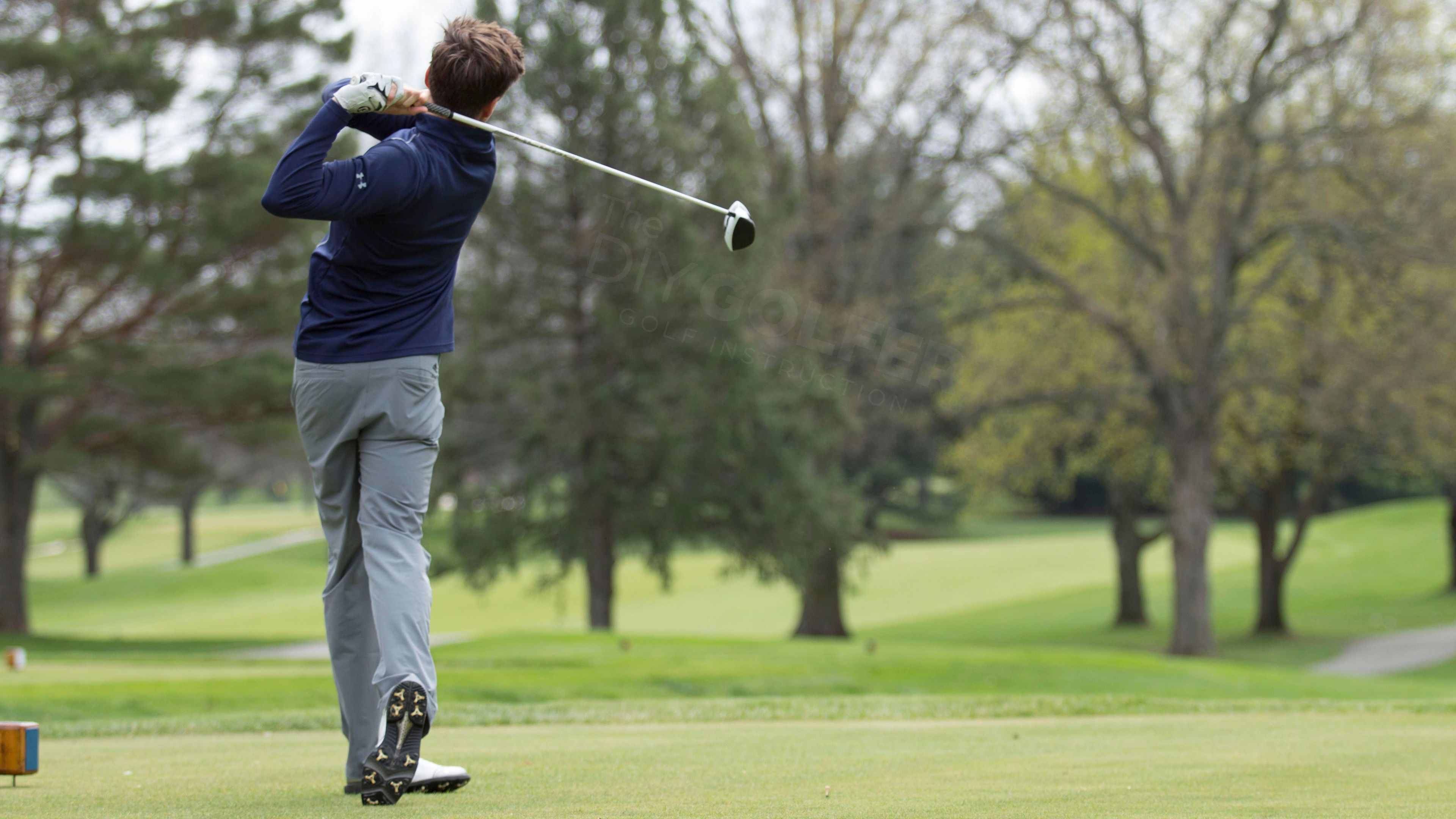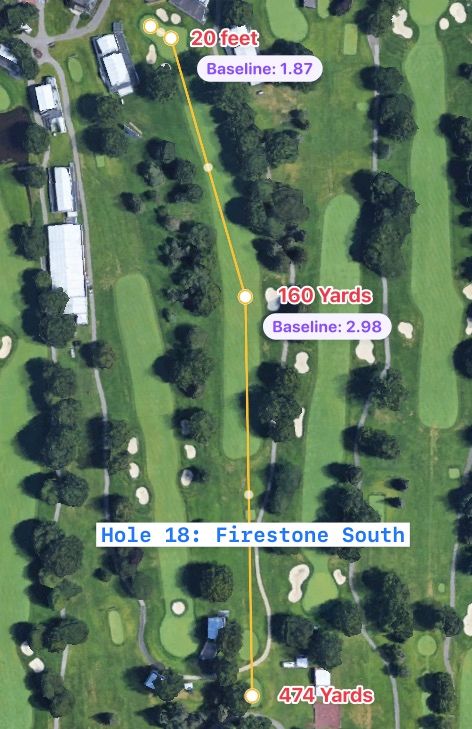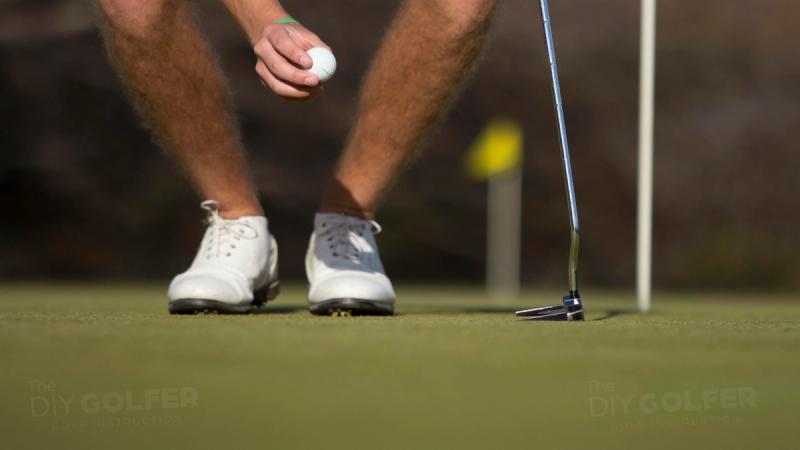Table of Contents

Last updated Jan 18, 2024
What is Strokes Gained Off the Tee? Explained.
Strokes gained off the tee is an objective way to measure a golfer's driving ability. In this post, I'll explain how it is calculated and why it matters.


For decades, the golf world has been saying, "Drive for show, putt for dough".
While a "hot putter" significantly increases the chance of winning a pro tournament, tour players rely on their long game to build a successful career in golf.
Driving is NOT just for "show".
But how much does it really matter? Using the strokes gained off the tee statistic, we can answer some of our most burning questions.
TLDR;
This statistic tells us how well a golfer drives the ball off the tee.
What is measured?
Strokes gained off the tee include all tee shots except par 3 tee shots (those are part of the strokes gained approach metric).
Calculation and Formula
The formula for strokes gained off the tee (SGT) is:
SGT = Avg. strokes to hole out (start) - Avg. Strokes to hole out (end) - 1
Where "Avg. Strokes" is a "benchmark" calculated from hundreds of thousands of golf shots from the tour's ShotLink system.
Can Amateurs use this stat?
Yes, I recommend Arccos for tracking your strokes gained statistics.
How much does driving matter in golf?
Before we dive into the calculation and methodology behind the strokes gained off the tee (aka "strokes gained driving") statistic, I want to start by answering some questions.
These are empirical by nature—I won't be diving into the numbers to prove them to you as Mark Broadie has already done that in his book, Every Shot Counts.
After studying hundreds of thousands of pro golf shots, what did Broadie find about driving distance and accuracy?
Does extra driving distance result in lower scores?
The answer is YES.
On average, for a tour pro, an extra 20 yards of distance results in ~0.75 strokes per round.
Guys like Dustin Johnson, Bryson Dechambeau, Bubba Watson, and more show up to golf tournaments with nearly a 1-stroke advantage thanks to their length off the tee.
Absolutely wild right?!
But you might be thinking, "But Zach, I don't believe this because driving accuracy matters a lot more than distance. You can't score well from the trees!"
While your thinking has good logic, you may be surprised by the numbers...
Is driving accuracy more important than driving distance?
In theory, "long and wild" golfers will not get that 3/4 stroke advantage that I just talked about. Sure, they can hit it 320 yards off the tee, but every third hole, they hit it out of bounds. That surely can't result in a stroke advantage, right?
You are 100% right.
But the surprising insight that Broadie stumbled upon in his analysis was this:
Longer hitters tend to be straighter hitters (across all skill levels).
And while this may not make sense at first, if you consider what it takes to produce long golf shots, this finding might not be as shocking.
To produce long drives, a golfer must have excellent swing mechanics. And excellent swing mechanics generally result in more accuracy, not less.
That said, this finding is a general conclusion and there are plenty of exceptions. There are plenty of long-hitting golfers who can't keep the ball on the course, but on average, extra yardage equals lower scores.
Long game is the biggest difference between pros and amateurs
Broadie ran some simulations with real pro and amateur data and came to a few more shocking findings. One of these was this table:
| Am Golfer Skill | Pro-Long/Am-Short | Am-Long/Pro-Short | Variance |
|---|---|---|---|
| 80s-golfer | 70 | 74 | 4 |
| 90s-golfer | 74 | 81 | 7 |
| 100s-golfer | 77 | 87 | 10 |
In his simulation, Broadie created two teams of golfers. On one team, a pro golfer hit all shots over 100 yards while an amateur hit all shots inside 100 yards. This was the "Pro-Long/Am-Short" group. On the second team, a pro golfer hit all shots inside 100 yards while the amateur hit all shots outside 100 yards. This was the "Am-Long/Pro-Short" group.
And as you can see, no matter what skill the amateur was, the group where the pro hit the long shots always won the match by a healthy margin.
This begs the conclusion—long game separates the pros and amateurs more than any other factor.
And if you take these findings at face value, you should be convinced by now how important it is to hit great drives off the tee.
What's wrong with traditional driving accuracy statistics?
One more thing before we dive into strokes gained off the tee.
What's wrong with the traditional fairway hit percentage statistic (aka "driving accuracy percentage")?
This statistic tracks what percentage of fairways a golfer hits during a round. Typically, there are 14 fairways on a golf course, so if a golfer hits 7/14, their fairway hit percentage is 50% for a round. The PGA Tour average for this stat is generally ~59% while most amateurs are well below 50%.
This statistic is great for simple measures of driving accuracy, but it falls short in several areas:
- It doesn't account for driving distance (that's a separate stat)
- It doesn't account for wind or weather conditions
- It doesn't account for the course difficulty (how wide the fairways are)
We need a more objective way to measure driving accuracy AND distance across all sorts of weather and course conditions.
That's where strokes gained off the tee comes in.
What is Strokes Gained Off the Tee?

Formally, the strokes gained off the tee stat measures all tee shots on par 4s and par 5s (no par 3s).
Strokes gained off the tee is one of several strokes gained statistics tracked by the ShotLink system on Tour. You can find the official statistics on the PGA Tour website. Amateur golfers can track this through systems like Arccos as I'll explain later in this post.
In the screenshot above, you can see that during the 2023 season, Scottie Sheffler led the tour in strokes gained off the tee. On average, Scottie gained 1.021 strokes on the field per round, and during the 2023 season, gained 75.522 strokes on the field over all his rounds.
While the official stat measures strokes gained off the tee by round, we can measure it in many different ways. Given the right data, we could measure strokes gained off the tee:
- For a single golf hole
- For a round of golf
- For a full golf tournament
- For an entire golf career
- Between two golf courses
- Between two golf tournaments
In other words, we could say that Scottie Sheffler "gained 1.8 strokes on the field during the Players Championship".
We could also say, "Over his career, Luke Donald has lost 0.9 strokes against his peers off the tee"
Or even, "Bethpage Black is one of the hardest tee-shot courses in the nation" (because of the course length).
I know, I know, this is confusing! Let's take a look at some examples to better understand the elusive strokes gained off the tee metric.
How is Strokes Gained Off the Tee Calculated?
Calculating strokes gained approach is simpler than you think! At its core, this metric revolves around comparing a player's tee shot performance to a benchmark, typically derived from data collected on professional tours like the PGA Tour. It's a great way to objectively assess how well a golfer performs off the tee.
Strokes Gained Off the Tee Formula
The basic formula for strokes gained off the tee is:
SGT = Avg. strokes to hole out (start) - Avg. Strokes to hole out (end) - 1
For example, let's say a player tees off on a par 4 that is 440 yards. Based on PGA Tour benchmarks, it should take this golfer ~4.08 strokes to hole out from this position and distance.
Next, let's say this player hits a whopping 340-yard drive, but misses to the right and ends up in the rough. This leaves the golfer 100 yards from the rough, and assuming he has a clear shot to green, the tour benchmark says this should take ~3.02 shots to hole out from.
So our formula is:
SGA = 4.08 - 3.02 - 1 = 0.06
In this example, our player has gained 0.06 strokes on the field.
We also must subtract 1 at the end to account for the stroke taken.
If the player would have hit the same shot, but ended in the fairway, we could update our formula:
SGA = 4.08 - 2.8 - 1 = 0.28
As you can see, SGA is a function of location (fairway, rough, sand, etc.) and proximity (how close the ball ended to the hole).
Let's walk through the in-depth methodology below.
Basic Calculation Methodology
As with other strokes gained statistics, strokes gained approach is tracked using the following basic methodology:
- Establish a Baseline: The baseline is the average number of strokes a player takes to hole out from a given location and distance. For example, if a golfer is teeing off a 440 yard hole, the baseline might be ~4.08 strokes. If an amateur is calculating strokes gained, they will typically compare to players of similar handicaps (skill levels) through an ecosystem like Arccos.
- Compare Individual Performance: Next, we compare a player's performance to this baseline (as shown in the prior-section calculation)
- Aggregate Data Over Rounds: This process is repeated for every shot in a round, and the values are aggregated. Positive values indicate better-than-average driving performance, while negative values suggest there's room for improvement.
Step 1: Establish a baseline
For our baseline, we'll look at a small sample of PGA Tour benchmarks. These numbers are not exactly what is used on tour (those numbers are constantly being updated), but are very close as they were sampled from Mark Broadie's book, Every Shot Counts:
| Distance (yds) | Tee | Fairway | Rough | Sand | Recovery |
|---|---|---|---|---|---|
| 500 | 4.41 | 4.53 | 4.72 | 5.11 | 5.17 |
| 460 | 4.17 | 4.29 | 4.48 | 4.87 | 4.93 |
| 400 | 3.99 | 4.11 | 4.30 | 4.69 | 4.75 |
| 360 | 3.92 | 3.95 | 4.11 | 4.41 | 4.56 |
| 300 | 3.71 | 3.78 | 3.90 | 4.04 | 4.20 |
| 200 | 3.12 | 3.19 | 3.42 | 3.55 | 3.87 |
| 100 | 2.92 | 2.80 | 3.02 | 3.23 | 3.80 |
We'll start by looking at the second column, which represents the expected number of strokes at varying distances from the tee.
Step 2: Compare Individual Performance
For this example, let's say Tiger Woods is playing the 18th hole at Firestone South course during the WGC Bridgestone Invitational:

Let me start with an important note—we're ONLY looking at strokes gained off the tee here. Remember, strokes gained putting and strokes gained approach are separate metrics.
On this hole, Tiger hit his tee shot from 474 yards and it ended up in the fairway, just 160 yards from the hole (a 314 yard drive).
Since 474 yards is between numbers in our table above, we'll interpolate between the 500 yards and 460 yards number to get an expected number of strokes around 4.25. From 160 yards, the expected number of strokes is ~2.99. So we can use these benchmarks to calculate Tiger's strokes gained off the tee for this hole:
SGT = 4.25 - 2.99 - 1 = 0.26
Turns out, ripping a 314-yard drive down the middle gains some strokes on the field!
Step 3: Aggregate
Now that you understand the individual calculation, we just need to go through this process for every hole during this round and sum them all up to get the official strokes gained off the tee metric that the PGA Tour tracks.
Finally, we can average it for all rounds of a season to get an annual metric. Below, you can see Tiger's strokes gained stats for 2007. He was 8th on tour for the strokes gained off the tee stat and on average, gained 0.624 strokes every round on the field from the tee! Pair that with a first-place ranking in strokes gained approach and strokes gained putting and that's a heck of a season.

Can Amateur Golfers Use Strokes Gained Off the Tee?
At the time of writing, the golf industry has come a long way with consumer-grade technology. With the proliferation of shot trackers and personal launch monitors, it has become easier for amateur golfers to assess their games with real on-course data.
That said, tracking strokes gained off the tee statistics still proves difficult for many golfers.
Why?
Because as we talked about earlier, strokes gained calculations require benchmark data.
This means that for a 15-handicap golfer to assess their game with strokes gained approach data, all of the following things must be tracked:
- Every tee shot must be tracked (ending location AND distance)
- Thousands of golfers who play to a 15 handicap must also track their tee shots
- All this data must be aggregated in one spot (ecosystem)
For the PGA Tour, this is easy. ShotLink tracks every golf shot from every tournament for every tour pro automatically.
For us amateurs, we don't have this luxury (and frankly, most of us probably don't want all of our shots tracked!)
There are a few options though and I'm excited to see how this evolves in the next decade!
Option #1: Automatic Tracking
In my opinion, automatic strokes gained tracking is the best option. Tracking every shot for every round you play is exhausting and most golfers do not have the discipline to keep this up over a long enough period for it to start helping their games.
At the time of writing, here are a few shot trackers that also have strokes gained statistics built-in to their ecosystems:
- Arccos Shot Trackers: The Arccos system has strokes gained calculations available to users (via the app) and thanks to all the amateur data they have collected, you can compare your rounds against golfers of similar skill levels. This is a huge benefit and allows for the most accurate strokes gained data.
- ShotScope Trackers: A close second to Arccos, ShotScope offers shot trackers and an app that calculates strokes gained data. From what I've seen, ShotScope does not have quite as many data points as Arccos, but is a great alternative.
Option #2: Manual tracking
Several apps allow you to track all of your shots manually and then review strokes gained data within the dashboard. While this can be cumbersome and exhausting to some golfers, it is a great option if you are highly disciplined and dedicated to improving your golf game.
Here are a few to check out:
- My Round Pro
- PinPoint Golf
- Decade Golf: This is more of a system than an app. While it does have an app, this is a premium service you pay for to help learn better golf strategy based on strokes gained data.
Other Strokes Gained Statistics
At this point, you might be thinking—"Zach, we've talked a lot about approach shots, but what about the rest of my game?"
And you would be correct.
Strokes gained is more than just tee shots. It is an entire framework for measuring relative golf performance in all areas of a golfer's game:
- Strokes gained off the tee (this article)
- Strokes gained around the green
- Strokes gained putting
- Strokes gained approach
Concluding Thoughts
If there's anything you can take away from this post, it's this—don't be afraid to work on distance. While many coaches may encourage you to "swing easy" for more accuracy, that's only a short-term solution. It can also be a great drill.
Most golfers work on distance the wrong way. They try a bunch of "quick fix" drills to add distance when really, they just need to work on the basics of the golf swing.
As I mentioned earlier in this post, there is a positive correlation between long hitters and accuracy because most of these hitters have great mechanics!






